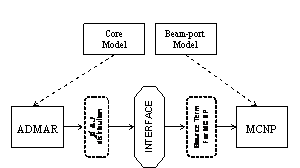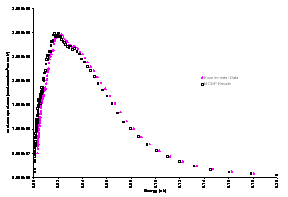
Modelling of Existing Beam-port Facility at Penn State University Breazeale Reactor by using MCNP
| Participants: | Kenan Ünlü, Professor of Mechanical and Nuclear Engineering |
| Jack S. Brenizer, Professor of Mechanical and Nuclear Engineering |
| Kostadin Ivanov, Associate Professor of Nuclear Engineering | |
| Yousry Azmy, Professor of Nuclear Engineering | |
| F. Alim, Graduate Student | |
| B. Sarikaya, Graduate Student |
| Services Provided: | Neutron Beam Laboratory |
| Sponsors: | U.S. Department Of Energy-Innovations in Nuclear Infrastructure and Education (INIE) |
Introduction
The Radiation Science and Engineering Center (RSEC) facilities at The Pennsylvania State University (PSU) include the Penn State Breazeale Reactor (PSBR), gamma irradiation facilities, and various radiation detection and measurement laboratories. The PSBR is the nation's longest continuously operating reactor that went critical in 1955. The PSBR is a 1 MW, TRIGA with moveable core in a large pool and with pulsing capabilities. The core is located in a pool of de-mineralized water. When the reactor core is placed next to a D 2 O tank and graphite reflector assembly near the beam port locations, thermal neutron beams become available for neutron transmission and neutron radiography measurement from two of the seven existing beam ports (BP).
When the PSBR reactor was built MTR type fuel elements with active length of 24” were used. With the MTR fuel the beam port arrangement did not limit the maximum neutron output. In the mid 60's the PSBR was converted from MTR type to TRIGA type fuel (active length of TRIGA fuel is 15”). With TRIGA fuel, only one beam port is at the centerline of the core active area, four beam ports are five inches below the centerline and two are eleven inches below the centerline (below the active fuel region). Only two beam ports are currently being used. BP #4 which is located axially at the centerline of the reactor core is used for research, primarily neutron radiography and radioscopy, and BP #7 with its lower neutron flux level is used for service activities involving neutron transmission measurements. Due to inherited design issues with the current arrangement of beam ports and reactor core-moderator assembly, the development of innovative experimental facilities utilizing neutron beams is extremely limited. Therefore, a new core-moderator location in PSBR pool and beam port geometry needs to be determined in order to build useful neutron beam facilities. A study is underway with the support of DOE-INIE funds to examine the existing beam ports for neutron output and to investigate new core and moderator designs that would be accessible by new additional beam ports.
Description of Work
Core calculations are performed by using the diffusion code ADMAC-H [1], which utilizes a few-group cross-section library developed with HELIOS [2]. Since the geometrical and material configuration of the beam-port facility is complex the MCNP [3] code is used instead of the deterministic codes because of its geometrical flexibility. An interface program has been developed at PSU to link the diffusion code to the neutron transport code. This interface basically reads the ADMARC-H output then computes the source term for MCNP and finally prepares the necessary MCNP input card at the requested format. Fig.1 shows the schematic view of the overall simulation. The reactor core model used for this simulation is given in Figure 2. This model includes also the D 2 O tank reflector.


Fig.1. The schematic view of the simulation package Fig. 2. The core model
The ADMARC-H Model
The PBSR TRIGA core was first loaded in 1965. Currently, the PBSR is operated using core cycle 51 and the simulation core model is based on this configuration of the core. The model has been validated using measured data from TRIGA. The uniform lattice in PBSR is formed in hexagonal shape. The center of the core is the location of the central thimble (the water rod), which is surrounded by hexagonal rings. There are 94 fuel rods; 30 of them are 12 wt % and 64 of them are 8.5 wt %, both with a 20 wt % uranium-235 enrichment. Three control rods (shim, regulating and safety) are fuel follower control rods driven by motor. They are composed of graphite at the top and bottom, fuel and absorber (borated graphite) in the middle. The fourth control rod is the transient rod (air rod), the only control rod without fuel material driven by an electro-pneumatic during the steady-state operation. The core model also includes the D 2 O reflector.
The MCNP Model
The MCNP model consists of the D 2 O tank and the beam port tube with their surroundings. Preliminary runs showed that modeling of the whole system with MCNP is computationally very expensive. Therefore, the overall MCNP model is broken up into two parts, namely a D 2 O tank model and a beam-port model. The MCNP part of the simulation is performed in two steps. First, the D 2 O tank model, which contains the source information from the interface code and geometry data for the D 2 O tank is run. Then, the output of the D 2 O tank model is used as the input for the beam-port model. Finally the beam-port model is run with this input data.
Results and Discussion
The neutron spectrum at the exit of BP#7 was measured using a single disk neutron chopper at 1 MW reactor power [4]. We modeled the core, D 2 O tank and beam-port by using the PSU simulation package shown in Fig.1 The measured neutron spectrum is compared with the result of the model simulated with our package in Fig.3.

Fig. 3. Comparison of the results of beam-port model with the experimental data
Conclusions
The preliminary results show very good agreement with the experimental data. In order to further test the accuracy of the intermediate calculations performed in between two MCNP calculational steps, a full model case is also being performed.
References
• K. Ivanov , N . Kriangchaiporn , “ADMARC-H Manual”, The Pennsylvania State University , 2000.
• “HELIOS Methods”, StudsvikScandpower, 2000.
• X-5 Monte Carlo Team, “MCNP - A General Monte Carlo N-Particle Transport Code, Version 5, Volume I: Overview and Theory”, LA-UR-03-1987, April 24, 2003
• J. H. J. Niederhaus, “A Single-Disk-Chopper Time-of-Flight Spectrometer for Thermal Neutron Beams.” M. Sc. Thesis, The Pennsylvania State University , August 2003

